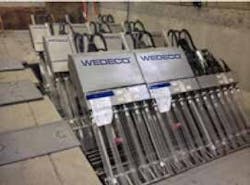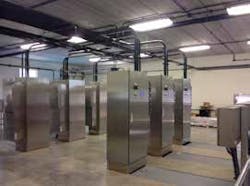Wedeco Duron UV Disinfection System in Rensselaer County, NY
The communities serviced by the Rensselaer County Sewer District, collectively known as the Albany Pool, have combined sewer systems (CSS) that bring stormwater, sewage and industrial wastewater directly to the wastewater treatment facility. When a storm or snow melt results in exceeded capacity, local waterways become contaminated, resulting in a significant environmental challenge, especially in a community where recreational swimming, boating and fishing are popular in warmer months. From 1976 to 1987, Rensselaer County Sewer District in upstate New York disinfected water with chlorine, but this practice was discontinued due to dangers associated with chlorine gas.
Scope
In 2014, a cross-county plan to improve the water quality in the Albany Pool section of the Hudson River, a $400,000 incentive from the State of New York, and an innovative technology caused the area to decide to disinfect their water again.
The Rensselaer County Sewer District water treatment facility is designed to treat 24 million gallons per day (MGD), peaking at 63.5 million gallons at certain times of the year.
“In order to disinfect that volume, we needed a new system,” said Gerard S. “Gerry” Moscinski, P.E., Administrative Director, Rensselaer County Sewer District.
“With this fluctuation and an average daily flow of 16.5 million gallons of water, a state-of-the-art system that was efficient and easy to maintain was a must,” said Moscinski.
Solution
The Rensselaer County Sewer District installed a Wedeco Duron UV disinfection system to achieve its disinfecting goals. With 216 UV lamps, the Duron product is a 45-degree inclined ultraviolet open channel system, eliminating the need for chemical disinfection. The new inclined design utilizes the latest 600-watt Ecoray® lamp technology, which combines reduced replacement components with minimized energy and footprint requirements.
Safety for employees, the community and environment were key considerations in choosing a UV system to once again disinfect wastewater at the Rensselaer County Sewer District. “We didn’t want to have to deal with the dangers of chlorine, or the associated costs,” said Moscinski. “A UV treatment system meant we wouldn’t have 30 tons of chlorine brought in to the facility on a regular basis, which would be a hazard and an accident waiting to happen.”
In addition to eliminating the need for chlorine storage, UV systems effectively eliminate up to 99.99% of pathogens — including bacteria, viruses, and parasites — without any harmful chlorine byproducts and without adding harmful chemicals to the water.
The Duron UV system was ultimately chosen because of its innovation and a total cost that fit the overall plan. Additionally, it eliminated the need for an overhead crane, which reduced certain dangers and risks, including breaking lamps.
Result
Most notably, there has been a major improvement in the water quality standard for the Albany Pool due to the installation of the Duron UV system. There is a significant change in water quality simply by disinfecting.
The community has its recreational waterway back as well. According to a Department of Environmental Conservation (DEC) press release at the time of the installation, it will be safe for residents to resume recreational activity as soon as 10 hours after a normal rainstorm, as opposed to the water being unsafe for days after a heavy rainfall.
Editor's Note: Scranton Gillette Communications and the SGC Water Group are not liable for the accuracy, efficacy and validity of the claims made in this piece. The views expressed in this content do not reflect the position of the editorial teams of Water & Wastes Digest, Water Quality Products and Storm Water Solutions

